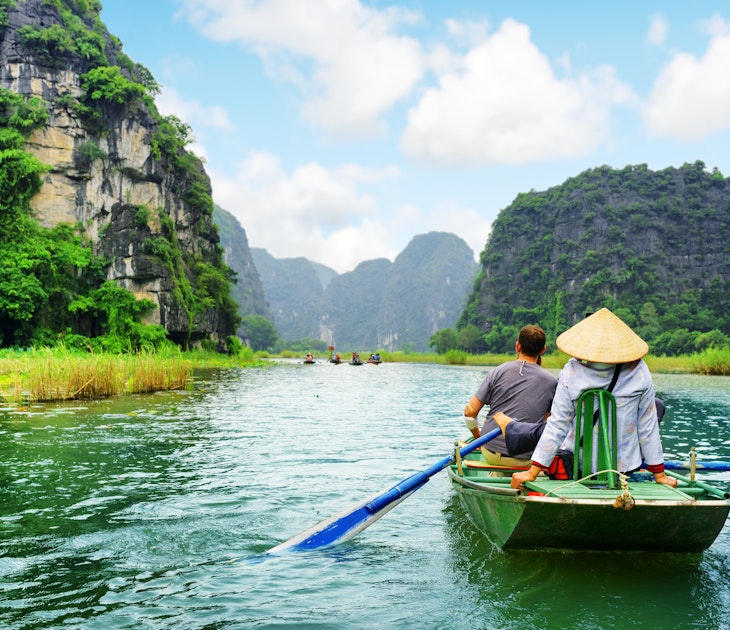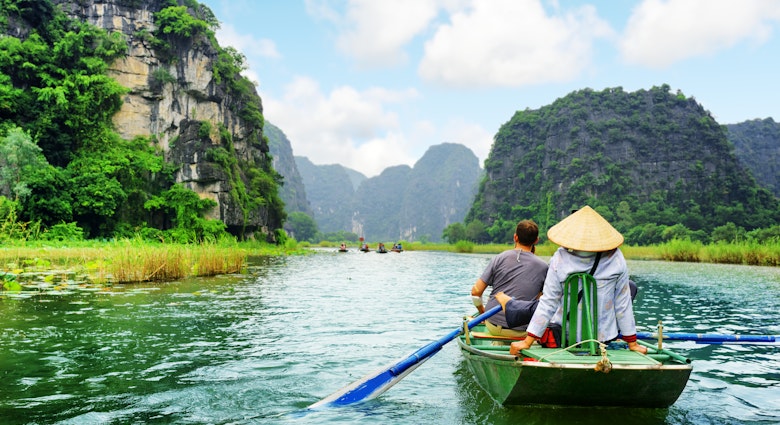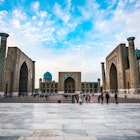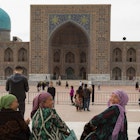Trucks and trains may have replaced the camel caravans of old, but there are still many joys to be had from simply getting around in Uzbekistan, from the stunning Soviet-era decor of Tashkent’s magnificent metro to overnight train trips across the Central Asian steppe.
Using a combination of trains, shared taxis and even car hire, you can travel along ancient Silk Roads between Khiva and Bukhara, or follow in the footsteps of Genghis Khan and Alexander the Great en route to such storied places as Bactria or the Fergana Valley. Indeed, getting from A to B in Uzbekistan is half the fun.
Read on for our best travel tips, whether you are planning a trip by train or shared taxi, taking a private tour or even driving yourself.

Travel the Silk Road by train
Crossing Uzbekistan by train is a bucket-list trip in itself for many travelers, especially when combined with an epic trans-continental rail trip across the Kazakh steppe to the deserts of western China. Train lines run across the breadth of Uzbekistan, from Nukus in the far northwest to the capital, Tashkent, and on into the Fergana Valley or to Termiz on the southern border with Afghanistan. It’s a superbly romantic way to traverse the country.
There are two main types of train. Modern, high-speed, Spanish-built trains with airplane-style seating run from Tashkent to Samarkand and on to Bukhara; take your pick from fast Afrosiyob trains (2½ hours) and slightly slower Sharq services (3 hours). Modern express trains also run from Tashkent to Kokand, Margilon and Andijon in the Fergana Valley. These services are without a doubt the best way to travel between Uzbekistan’s major Silk Road sights.
The other main type of trains are the slower, Soviet-style long-distance services, which trundle at a more sedate pace, but are useful for overnight trips. Sleeper services run from Tashkent to Bukhara (8 hours), Khiva (14 hours), Nukus (22 hours) and Termiz (15 hours). There’s even a 23-hour Khiva-Andijon service traversing the full length of the country.
You can choose from two-berth carriages (SV class), four-berth carriages (kupe) or open carriages (platskartny); beds are not luxurious but are comfortable enough. Traveling by kupe is the best choice for most visitors, and you’ll save the cost of a night’s accommodation. Bring food and drink with you and share it with your new carriage companions before you nod off to the gentle clanking of the train as it crosses the Central Asian steppe.
Book train tickets as far in advance as you can (up to 45 days), ideally online or via the useful Uzbekistan Railways app. Failing that, you can book at the VIP counter at the railway station or more centrally-located city train ticket offices.
Rub shoulders with the locals in a shared taxi
For shorter intercity runs, a seat in a shared taxi is the most convenient way to travel. Groups of track-suited drivers hang around designated taxi stands in most cities and as soon as all four passenger seats are occupied, the journey begins, often at hair-raising speeds. For maximum comfort, try to score the front seat, or, if you are a couple, pay for all three seats in the back.
It helps if you can speak a few words of Russian or Uzbek and know the approximate fare before you board, to reduce the chance of being overcharged. Useful shared taxi routes link Bukhara to Khiva and connect the cities of the Fergana Valley; there’s also a convenient route from Samarkand over the mountains to Shakhrisabz. Shared taxis are also the best way to get between land borders and the nearest town.

Get around town by marshrutka
The Russian word marshrutka means "route" and the term is used for any minibus that follows a fixed itinerary, as well as slightly larger intercity minivans. You’ll see these tiny metal cans zipping around larger cities and they can be useful for local sightseeing, if you can work out where they run to. The downside is that they are often very cramped.
Be wowed by the Tashkent Metro
Tashkent’s wonderful Soviet-built metro system was constructed after the 1966 Tashkent earthquake by the same team that built Moscow’s famously ornate metro system. As well as being the best way to get around the sprawling capital, it’s also a sight in itself, with stunning decor in the stations that ranges from psychedelic spacescapes in Kosmonavtlar (Cosmonought) station to Central Asian motifs at Alisher Navoi. Photographs are now allowed in all stations.
Individual tickets cost less than US$0.15, regardless of how far you are traveling, meaning you can do a tour of unlimited stations for the price of a single ticket, so long as you don’t leave the metro. There are three lines, which intersect at three key stations, and a fourth circle line is under construction.
Use Uzbekistan’s taxi apps to save
Official city taxis are marked by company name or a checkered black and white sign on the dashboard, but many private cars also run as unofficial taxis. You’ll need to negotiate a fare before getting in, but in general fares are good value. It’s always a good idea to use official taxis or book a taxi if you are traveling late at night.
If you have a smartphone with a local SIM card, you can download the Russian Yandex Go, Yango or MyTaxi apps once you arrive in Uzbekistan (they can’t be downloaded from abroad) and then use these Uber-style apps to hail fixed-rate taxis. It’s much easier than negotiating in Russian with a reluctant taxi driver. You’ll see the fare in the app and payment can be made with a card or in cash.
Buses are a vanishing form of transport
In general buses are the worst way to get around Uzbekistan. Long-distance coaches are slow and unreliable, if you can even find one these days. Local bus routes within larger cities are more useful; Tashkent has a new fleet of electric buses.

Traveling by bike is for determined cyclists only
Some long-distance cyclists pedal their way across Uzbekistan but in general Tajikistan and Kyrgyzstan are much more popular cycling destinations. Intercity cycling can be an ordeal in Uzbekistan thanks to the summer heat and hassles with registration when camping.
Hire a car and driver for a comfortable private tour
Private drivers aren’t hard to find for city tours or for day trips, such as the popular journey from Samarkand to Shakhrisabz, or from Khiva to the desert fortresses of Karakalpakstan. Any B&B or travel agency can put you in touch with a reliable driver; multi-day trips are also possible given some advance notice.
Self-drive the Silk Road for a proper adventure
It’s now possible to rent a car without a driver through companies like RentCar.uz and the international company Sixt, so you can now drive yourself along the golden road to Samarkand. You won’t need an international driving license but you will likely need to leave a large cash deposit.
Strap in for an Uzbekistan Airways flight to save time
Uzbekistan Airways runs a reliable and inexpensive network of flights across the country, and safety standards are comparable to most international carriers. Most useful are the daily flights from the hub Tashkent to Nukus and Urgench, but there are also services to Bukhara and elsewhere.
You can buy tickets online through most international ticket sites or at any aviakassa (ticket office) around town. A one-way flight from Tashkent to Nukus or Urgench can cost as little as US$60, taking less than two hours, compared to 13 hours by road.
Accessible transportation in Uzbekistan
Local operators have limited experience of catering to disabled travelers; combined with the tangled layout of historic cities such as Bukhara and Khiva, this can make Uzbekistan a challenging place to get around for people with limited mobility. That said, the modern Afrosiyob train from Tashkent to Samarkand and Bukhara has a designated space with secure anchorage for wheelchairs in one of the carriages, as well as a nearby accessible toilet.
Beyond that, the best advice is to hire a minivan or taxi (or pay for all seats in a shared taxi) and put your folding wheelchair in the back. At regional airports, passengers usually embark and disembark using moveable stairs, so domestic air travel is not that convenient for travelers with mobility problems. See Lonely Planet’s Accessible Travel Resources for more information.












